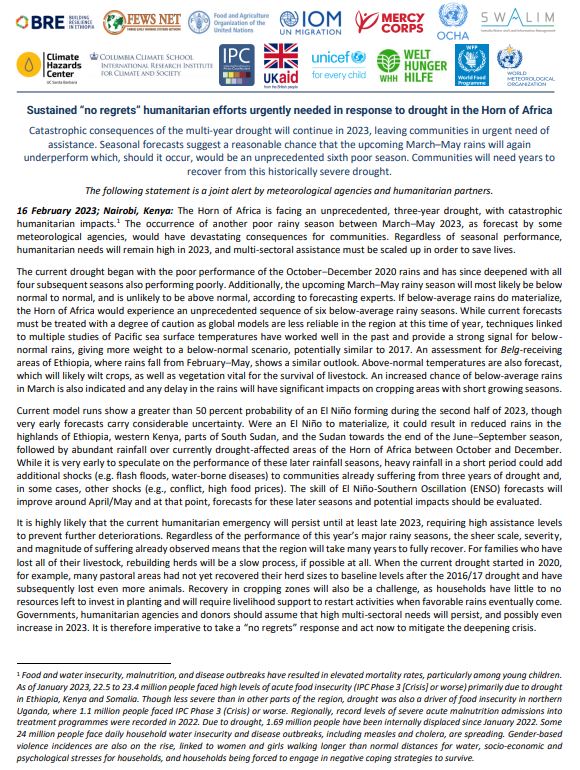Sustained “no regrets” humanitarian efforts urgently needed in response to drought in the Horn of Africa
The following statement is a joint alert by meteorological agencies and humanitarian partners.
16 February 2023; Nairobi, Kenya: The Horn of Africa is facing an unprecedented, three-year drought, with catastrophic humanitarian impacts.1 The occurrence of another poor rainy season between March–May 2023, as forecast by some meteorological agencies, would have devastating consequences for communities. Regardless of seasonal performance, humanitarian needs will remain high in 2023, and multi-sectoral assistance must be scaled up in order to save lives.
The current drought began with the poor performance of the October–December 2020 rains and has since deepened with all four subsequent seasons also performing poorly. Additionally, the upcoming March–May rainy season will most likely be below normal to normal, and is unlikely to be above normal, according to forecasting experts. If below-average rains do materialize, the Horn of Africa would experience an unprecedented sequence of six below-average rainy seasons. While current forecasts must be treated with a degree of caution as global models are less reliable in the region at this time of year, techniques linked to multiple studies of Pacific sea surface temperatures have worked well in the past and provide a strong signal for belownormal rains, giving more weight to a below-normal scenario, potentially similar to 2017. An assessment for Belg-receiving areas of Ethiopia, where rains fall from February–May, shows a similar outlook. Above-normal temperatures are also forecast, which will likely wilt crops, as well as vegetation vital for the survival of livestock. An increased chance of below-average rains in March is also indicated and any delay in the rains will have significant impacts on cropping areas with short growing seasons.
Current model runs show a greater than 50 percent probability of an El Niño forming during the second half of 2023, though very early forecasts carry considerable uncertainty. Were an El Niño to materialize, it could result in reduced rains in the highlands of Ethiopia, western Kenya, parts of South Sudan, and the Sudan towards the end of the June–September season, followed by abundant rainfall over currently drought-affected areas of the Horn of Africa between October and December. While it is very early to speculate on the performance of these later rainfall seasons, heavy rainfall in a short period could add additional shocks (e.g. flash floods, water-borne diseases) to communities already suffering from three years of drought and, in some cases, other shocks (e.g., conflict, high food prices). The skill of El Niño-Southern Oscillation (ENSO) forecasts will improve around April/May and at that point, forecasts for these later seasons and potential impacts should be evaluated.
It is highly likely that the current humanitarian emergency will persist until at least late 2023, requiring high assistance levels to prevent further deteriorations. Regardless of the performance of this year’s major rainy seasons, the sheer scale, severity, and magnitude of suffering already observed means that the region will take many years to fully recover. For families who have lost all of their livestock, rebuilding herds will be a slow process, if possible at all. When the current drought started in 2020, for example, many pastoral areas had not yet recovered their herd sizes to baseline levels after the 2016/17 drought and have subsequently lost even more animals. Recovery in cropping zones will also be a challenge, as households have little to no resources left to invest in planting and will require livelihood support to restart activities when favorable rains eventually come. Governments, humanitarian agencies and donors should assume that high multi-sectoral needs will persist, and possibly even increase in 2023. It is therefore imperative to take a “no regrets” response and act now to mitigate the deepening crisis.


